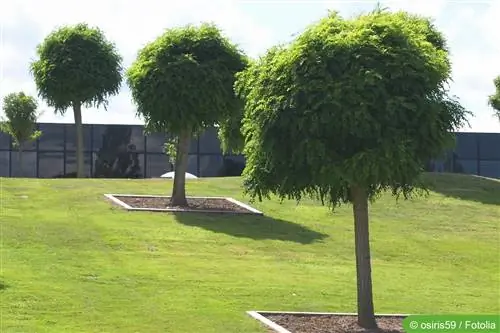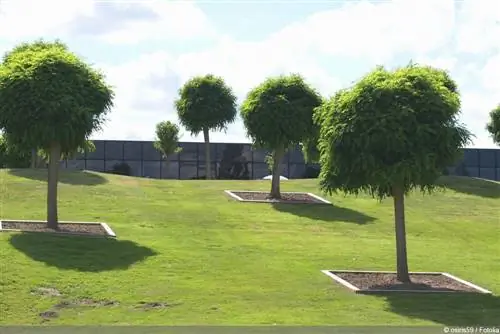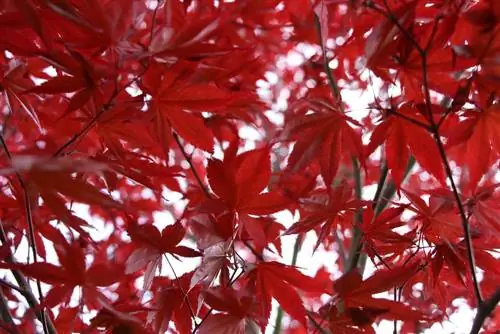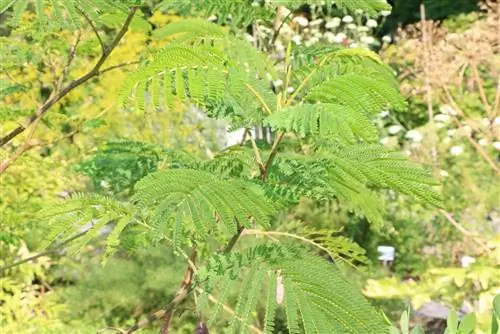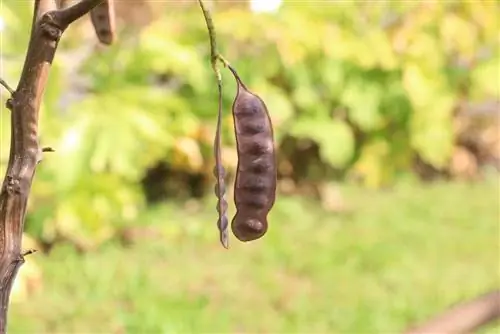- Author admin [email protected].
- Public 2023-12-17 03:39.
- Last modified 2025-06-01 06:48.
The ball acacia is a wonderful eye-catcher even in small gardens or front gardens, which impresses with its splendor of white leaves.
Location
If you decide to have a ball acacia in your garden, you should above all make sure there is enough space. This tree grows to be around five to six meters high and correspondingly wide. However, the crown can be grafted onto a half-stem or high-stem, meaning that it no longer grows in height, but only expands in width. However, it must be expected that the crown itself will grow very quickly. In addition to the individually appropriate space conditions, the location for the ball acacia should also be sunny, as both direct sunlight and heat do not affect the plant. However, it is quite sensitive to wind, especially the branches and twigs are so delicate that they quickly break when the air moves. The quality of the soil should be nutrient-rich and, if possible, even a little calcareous.
Plants
A ball acacia in the garden is not only a visual eye-catcher all year round, but also impresses with its undemanding nature and durability. Basically, it is important that the tree receives enough light and water to reveal its unique beauty. So that everyone can actually enjoy this easy-care tree in their garden or even on their terrace or balcony, there are several options when choosing plants. However, it is important to pay attention to appropriate specialist breeding from the plant trade or from a trusted garden trade. There are different versions of a ball acacia for your own garden; in addition to the root product, there are also specimens that grow in pots. Due to its many advantages, the ball acacia is a popular tree for the garden because it impresses with
- easy maintenance
- sunny location
- Optical enlargement of the space available
- Winter hardiness
- multi-year lifespan
If you decide to plant directly in the garden, you should buy a plant without balls directly from the tree nursery in autumn. Trees in potted containers, on the other hand, are available all year round, although it should be noted that successful planting is best done in the winter months. Once the optimal location has been found, a hole should be dug and the tree placed so that the base of the trunk is directly above the ground. As a support, so that the ball acacia stands securely in the initial period until it is firmly rooted, a post can be placed, which is connected directly to the tree with a cord.

In the initial period after planting, regular watering is very important; once the ball acacia is firmly rooted, it can supply itself with water and nutrients from the soil.
In pots - a gem for the terrace
These plants behave similarly to ball acacias in the garden when they are kept in pots. They are a real gem for every terrace or balcony, no matter how small, as the flowers are simply wonderful, especially in June. In addition, a strong but still pleasant scent spreads. The ground around the acacia trees is usually covered in tiny flower petals. What is particularly important for spherical acacias in pots is sufficient light and heat, but extensive fertilization or regular repotting is hardly necessary. However, it is important that potted acacias are cut back regularly - this is the only way the tree remains compact and resilient and can even be overwintered outdoors.
But be careful: children and pets should be kept at a distance from the plant parts of the ball acacia, as they are all poisonous. This also applies to the ball acacia when it grows in the garden.
pruning
In order to give the ball acacia the appropriate shape or to limit its height growth, regular pruning is recommended. In most cases, this does not have to be too radical, which is why it is also simply referred to as thinning. It is important that damaged or diseased branches are cut or sawn off directly at the base. If this affects the spherical shape of the tree, this can be remedied simply by cutting off a few more branches in the same way. If branches are damaged by storms or storms, the tree can be affected in essential parts.
In order to prevent the branch from breaking off completely, the ball acacia must be completely shortened. This must be done until a stable weight is achieved again and there is no longer any risk of the branches breaking. If, as a result, shoots appear on the shortened branch, they must be completely removed! This is the only way to ensure that the original spherical shape, which ultimately ensures the stability of the tree, is restored.
The acacia is best cut at the end of winter when the first shoots become visible. One of the advantages of this is that the appearance of the ball acacia is only affected for a very short time. However, if you don't mind unsightly pruned and trimmed branches, you can use a saw and pruning shears to tackle your ball acacia all year round, except in spring. The exception to this is, of course, the case where the tree is infested with pests. Then a radical cut must be made immediately.
What you should know in brief
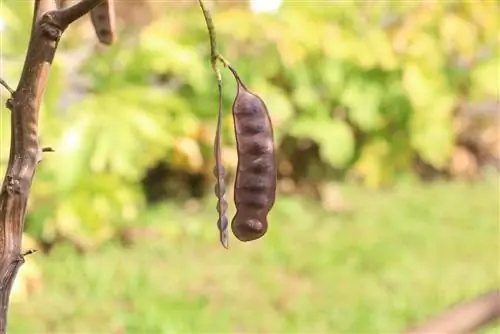
A ball acacia is a beautiful eye-catcher in every garden. The tree impresses as a design element and adapts to all styles of garden design. The filigree foliage of the ball acacias makes them appear graceful and fragile. Of all the acacia varieties, the trees are most suitable for smaller gardens, but also for front gardens in cities. They draw attention to themselves, which is why they are great to plant in places that you want to distract the eye from: a gray wall, a spot in the garden that otherwise doesn't get much care. What stands out is the tree.
- In June, when the acacias are blooming, it seems to snow. The ground around the trees is white from the tiny petals that fall.
- Their flowers hang down in long clusters, their scent is strong but is perceived as very pleasant.
- The ball acacia has almost no demands on the soil, although it is sensitive to wet, heavy soils, but not every plant can tolerate such soils.
- The ball acacia also grows on dry, barren soils, the main thing is that it gets enough light and warmth. She doesn't seem to care about anything else.
- Spherical acacias can also be kept very well in pots, they are an enrichment for every terrace, no matter how small.
- If you cut back the crown regularly, the tree will remain compact.
- Because ball acacias form a very lush crown, they make any small garden look a lot bigger, which is probably why these trees are often found in front gardens.
- But ball acacias are also wonderful as avenue trees, or as eye-catchers in parks and other green spaces.
- They easily reach a height of around 6 meters, and the width of the crown can also be this size.
- It tolerates heavy pruning before budding in spring.
- Despite its beauty, it should be noted that all parts of the ball acacia plant are poisonous.

